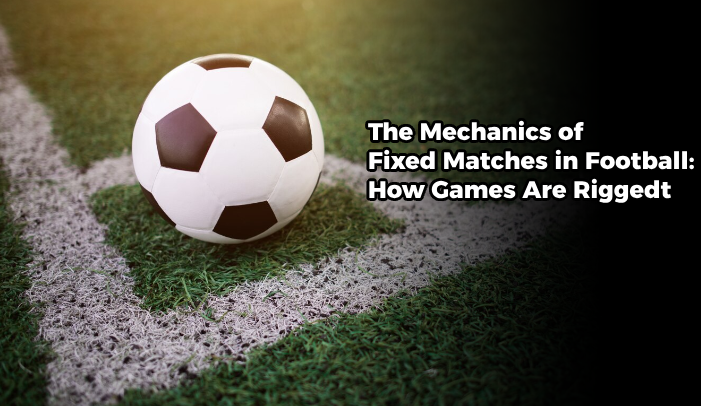Football is often called “the beautiful game,” but behind the scenes, there’s an ugly side that not many fans know about: fixed matches. 😱 Yes, even the sport that brings joy to millions can fall victim to corruption. So, what are fixed matches, and how do they work? Let’s pull back the curtain and dive into the secret world of rigged football games! 🕵️♂️

🤔 What Are Fixed Matches?
A fixed match is when the outcome or key moments of a football game are intentionally manipulated to benefit certain people, usually for financial gain. It could be a pre-arranged winner 🏆, a specific number of goals ⚽️, or even a yellow card 🟨 handed out at a particular moment. The game isn’t being played for the sport; it’s being played for profit.
🕵️♂️ How Are Matches Fixed? The Process Step by Step
Match-fixing doesn’t happen out of thin air. It’s a carefully planned operation that involves several shady characters and secret deals. Here’s how it typically works:
1. The Approach 💼
The first step in fixing a match usually involves someone from an illegal betting syndicate 🏦 approaching key people in the game, like players 👟, referees 🧑⚖️, or even club officials 👔. They’re offered a tempting bribe 💰 or sometimes threatened into cooperation.
2. Setting the Stage 🎭
Once they’ve got the right people on board, the fixer will lay out a plan. It could be something as small as ensuring a penalty is given at a specific time, or as big as determining the final result 🏁. These small actions are often called spot-fixing 🎯, while larger manipulations involve outcome-fixing.
3. Betting Bonanza 💸
The goal is to profit from the fix through illegal betting markets 📉. Syndicates place large bets on the pre-arranged outcome. The beauty (or rather, the tragedy 😞) is that the fixers know the result before the rest of the world. They rake in the cash while the fans are left in the dark.
🛠️ Methods of Manipulation: Tricks of the Trade
Match-fixing isn’t a one-size-fits-all operation. There are many different ways to rig a game, some subtle, others blatant. Here are a few common methods:
1. Player Mistakes (Intentional) ⚽️❌
A player might deliberately miss an easy shot on goal or make a clumsy tackle to get a yellow or red card. These small, seemingly innocent moments can sway the result of the game in major ways. 🤦♂️
2. Referee Decisions 🧑⚖️🛑
Referees are gatekeepers of fairness, but even they can be compromised. A biased ref can hand out penalties, red cards, or make poor offside calls at the perfect (or most inconvenient) moment, changing the tide of a match. 🟨🔴
3. Half-Time/Full-Time Fixing ⏳
One of the more complicated forms of fixing involves predicting both the half-time and full-time scores. For example, a team might be leading at half-time, but they’ll “conveniently” lose by full-time. This is often referred to as HT/FT fixing (e.g., HT 1-0, FT 1-2). 🕐
4. Goal Manipulation 🎯
Sometimes, the fix isn’t about who wins but about how many goals are scored. Fixers might arrange for the match to end with over or under a specific number of goals (e.g., Over/Under 2.5 goals). Each goal, or lack thereof, could mean big money 💵 for those in on the secret.
🤐 Who’s Involved? The Players Behind the Scenes
Now, you might be wondering, “Who’s pulling the strings here?” Let’s take a look at the cast of characters involved in fixed matches:
- Betting Syndicates 🏦: Often run by criminal organizations, these groups make large amounts of money by betting on the manipulated outcomes.
- Corrupt Players 🏃♂️: Not every player involved is corrupt, but those struggling financially or in lower leagues might be tempted to throw a game for some extra cash 💰.
- Referees 🧑⚖️: If a ref is involved, the match can be controlled with just a few key decisions: a penalty here, a card there.
- Club Officials 🎩: Sometimes, even those at the top can be part of the plot, helping to coordinate the fix from behind the scenes.
🚨 The Warning Signs of a Fixed Match
Although detecting fixed matches can be tricky, there are some telltale signs that experts look for:
- Unusual Betting Activity 📊: If there’s a sudden influx of large bets on an unlikely outcome, it raises red flags 🚩.
- Strange On-Field Behavior 🤨: Players missing easy chances or referees making bizarre decisions can be indicators that something isn’t right.
- Unexpected Results 💥: If a massive underdog suddenly beats a much stronger team in a surprising fashion, it could be cause for suspicion.
⚖️ The Fight Against Match-Fixing
Football authorities like FIFA and UEFA have been battling match-fixing for years. They’ve introduced strict measures to monitor games, players, and betting patterns. But it’s not easy. Fixers are constantly coming up with new ways to rig matches. Education campaigns aim to warn players about the dangers of getting involved, and law enforcement agencies regularly crack down on betting syndicates.
🎯 Conclusion: The Fight Continues
Match-fixing remains a stain on the world of football 🌍⚽️. While authorities have made progress in fighting it, fixers continue to adapt and find new ways to manipulate the game. The next time you watch a match, you’ll hopefully have a greater appreciation for the complexities at play—and the efforts being made to keep the sport fair. Keep your eyes open 👀, and always play fair! 🏆


